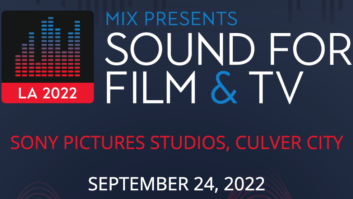
United Kingdom (May 21, 2020)—Most arena concerts follow the same game plan when it comes to setting up the PA. With the stage at one end, you put up left and right line array hangs on either side of the stage, some side hangs to cover fans perpendicular to the stage, a bunch of front fills and subs down at the front of the stage, and if there’s budget and a need, maybe some delay hangs at the other end of the room. Now, want to throw a wrench in the works? Throw in a B-stage elsewhere on the arena floor and figure out how to keep those left-right PA hangs from bleeding into the mics. That was the challenge the audio team faced on Stereophonics’ most recent UK tour.
Band leader Kelly Jones specifically requested a B-stage at the end of a 60-foot thrust emanating from the stage. The band’s longtime FOH sound engineer, Dave Roden, spec’d his preferred Martin Audio MLA loudspeaker system for the tour, which he mixed to via a DiGiCo SD5 console. Ultimately, system tech Nick Boulton envisioned and deployed a distributed PA, using the Martin MLAs, that ran the length of the thrust to the PA.

Production was running Audinate’s Dante networking protocol to the stage and sending AES3 protocol to the hangs, with Martin Audio UNET back-up. Monitor engineer, Sam Cunningham was using a DiGiCo SD7 on stage while Roden himself was on an SD5 at FOH.
Boulton explained, “We did some modelling with the aim of getting as much even coverage throughout the arena while keeping the weird noises off the stage. With the end of the thrust 60 feet into the room, it was well within the coverage area of MLA so we simply moved the hangs downstage.”
As a result, the conventional main stage L/R PA hangs were replaced by two side hangs further downstage, comprising, respectively, two drops of 16 MLA Compact as conventional outfills. Meanwhile, a further eight MLA Compact for infills were mounted on trusses set near the beginning of the thrust, and angled down.
Sight and Sound Sets Colorado Church’s New System
When Stereophonics headed out to the B-stage, that third of the show was heard via three hangs of 10 MLA and two MLD Downfills situated in the center and 90° upstage, forming a concentric arc at the end of the thrust. Three hangs of six MLX subwoofers were set behind that in end fire configuration. This design, Boulton felt, would reduce the sound bleed at the back of the stage, and help ease the room reflections.
Boulton leaned on the Hard Avoid setting in Martin Audio’s Display optimization software, not only creating rejection at the back of the stage but also the hard surfaces at the rear of the arena that would cause slapback. “We worked Hard Avoid to within an inch of its life,” he said. “Considering I had to take all the room measurements from scratch, and we have had to put hangs in different positions, it has been much quicker and easier than I had expected,” adding that at the new P&J Live Arena in Aberdeen, it took 25 minutes to build the plot.
Martin Audio • www.martin-audio.com






